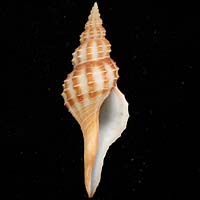|
< Previous family introduction |
|
 |
Family
Fasciolariidae
Tulip and spindle shells |
|
The shells of this family encompass a variety of shell form, from squat with a short canal in the genus Peristernia, a longer canal in Latirus, up to spindle shaped with a long canal in Fusinus. Sculpture is similarly variable with shells being smooth, or with axial folds, spiral ribs or nodules. The columella may be smooth or with plaits, and the outer lip smooth or lirate. Most species have a periostracum, and all have a corneous operculum. The subfamily occurs in both tropical and temperate waters from intertidal to at lest 500 m. in depth. The species with short anterior canals are typically tropical, living intertidally among rocks and coral. The spindle shells, with a long canal, live sub-tidally on sand. The species which occur in NSW are representatives of several different faunal distributions. Seven tropical Indo-West Pacific species are occasionally found in the north of the state, at the extreme southern end of their range. The large temperate southern Australian species reach as far north as central NSW or southern Queensland, all occurring sub-tidally in NSW, although they may occur intertidally in southern Australia. A third group occupies a small range in southern Queensland and NSW. Subfamily Reference: There is no modern comprehensive reference to the subfamily. Coverage All species known from NSW are covered here. Identification Notes Some species of this subfamily show extreme variation over their distributional and depth ranges. For example, Fasciolaria australasia occurs from the intertidal in Tasmania to 500 m deep in southern Queensland, the extreme forms being so different they are difficult to recognise as the same species. |